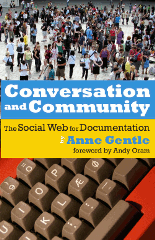Tom Johnson issues a polite
manifesto about moving STC’s publications online. (I am distracted by the use of the word manifesto and more so by its Wordnik
page. I’d like to blame this problem on the Internet, but I’m pretty sure that the Internet just lets me manifest (!) my attention problem more easily. OK, I’m banning “manifesto” from the rest of this post.) Here’s Tom:
When I hear these discussions, it blows me away because I can hardly believe what I’m hearing. I admit, the look and feel of paper can provide a comfortable reading experience if you’re immersed in a 200 page novel lying on your bed on a rainy day. But the Intercom and other professional magazines or journals are not novels. With professional publications like these, the online format better matches the reading behavior of the audience. In fact, online formats provide more than a dozen advantages that print formats lack, including everything from interactivity to portability, feeds, metrics, multimedia, and more.
I am fundamentally in agreement with Tom’s manif….er, declaration of principles. For balance, I would like to address the advantages of printed content over online content. They include the following:
Higher resolution
The printed page generally has a resolution of 600 dpi (printed at the office) or 1200 dpi (printed on a printing press). On-screen, you have a resolution of around 100 dpi. Therefore, printed content has a resolution that’s around 36x higher than screen content. (100 dots per inch is 100 pixels times 100 pixels, or 10,000 pixels per inch. 600 dpi is 360,000 pixels per inch.)
There are other technical issues (such as light being absorbed/reflected on paper versus being emitted from a screen) why text on paper is easier to read than text on screen.
Batteries and electrical power
Paper doesn’t require batteries or electricity to operate. This matters most for toilets and airplanes. And airplane toilets.
Universal access format
Once you have a paper copy, you can access your data. The same thing is not necessarily true online. For instance, you can have browser compatibility issues with HTML, problems with PDF versions, digital rights management obstacles, problems with logons for private content, and so on.
Better layout
Print (and PDF) give you sophisticated options for layout that go far beyond what you can do online with HTML.
Familiarity
As a society, we have hundreds of years of experience with books and magazines. This is not true for online content.
Engaging your senses of smell and touch
I think this issue is often overlooked when evaluating print versus online. The physical experience of holding a book, the smell and feel of high-quality paper, the sensation of pages sliding past your fingers as you turn the page — all of these are lost in the digital experience.
Authority
Printed content conveys authority in a way that web-based content does not. I believe that this is related to some of the factors I’ve outlined above. We know how to evaluate printed publications for quality — we look for attractive design, glossy paper, high-impact color, and so on. There’s a reason why the cliché is that you
shouldn’t judge a book by its cover. We do. (See also: “Understanding Judgment of Information Quality and Cognitive Authority in the WWW,” Soo Young Rieh and Nicholas J. Belkin,
PDF link)
But even though I can make a decent argument for the merits of printed publications, Tom is absolutely right, at least as it pertains to STC, when he says that:
Any organization or company would be crazy not to convert their paper-based magazine, journal, or newsletter into an interactive online format.
He’s laid out (cough) the arguments for online content in some detail, so I am going to focus on something a little different. I’d like to take a look at the business case for moving publications from print to online. I do not have any useful information from STC on the actual costs, so I’m just going to make some estimates. (I would be happy to get the official cost information. Anyone?)
We have around 11,000 members, so let’s assume a print run of about that. Further, let’s assume that printing runs about $2 per copy (?) and postage about $1 (I have no idea). That gives us an estimate of $33,000 in direct printing and postage costs per issue. Multiply that by 10 issues per year, and you get somewhere around $330,000 in direct printing and postage costs per year. I am leaving out international postage and other complicating factors. There’s also the fact that STC is collecting additional funding for sending printed publications.
In addition, each printed issue incurs design and layout costs. Best guess? 100 hours per issue at oh, $50 per hour. So, that’s somewhere around $50,000 per year in layout costs.
Some things I am not taking into account:
- Initial magazine design. My 100-hour estimate is for flowing content into an existing design, placing graphics, generating the table of contents, and doing print production.
- Editing.
- Working with recalcitrant authors.
- Planning the magazine content/setting the editorial content.
- The income side of the equation — fees specifically for international postage, for example
What would the equivalent costs look like for an XML or HTML-based workflow?
We eliminate printing and postage, so we save $330,000 per year. We probably save on the layout costs as well because publishing into HTML is so much less work. Total cost savings? Conservatively, it’s $330,000, if we assume no cost savings from reduction in layout work. (Note: If we continue to publish a PDF version of the magazine, we must keep the PDF layout costs as a line item and add a smaller amount for HTML-based publishing so maybe $300,000.)
I have been told that STC will lose advertising income if the magazine goes online only. I would agree that advertisers will pay less for online advertising as opposed to print advertising, but surely the advertising income would not drop all the way to zero. Let’s assume, however, that it does. The best estimate I have for advertising income is $143,159 (from Paul Bernstein’s detailed cost breakdown on the STC Ideas forum, accessible
here to registered members of the forum).
So, even if advertising drops to zero, we have a net positive of $150,000 from moving online. Implementing an XML or HTML-based magazine for the first time will cost a lot less than that. Therefore, the return on investment appears quite compelling.
You should be aware that I have no confidence in any of the numbers I have compiled here. I do not know the following with any certainty:
- Intercom print run
- Cost per printed copy
- Cost of postage
- Income from advertising
However, based on my experience in the industry, I think that the general ballpark figures are probably accurate. I would be delighted to update this post if someone can give me the real numbers.
So, Tom has laid out the argument for moving magazine content online based on quality. I have given you the argument based on cost, along with the reasons why you might prefer print.
What do you think?



